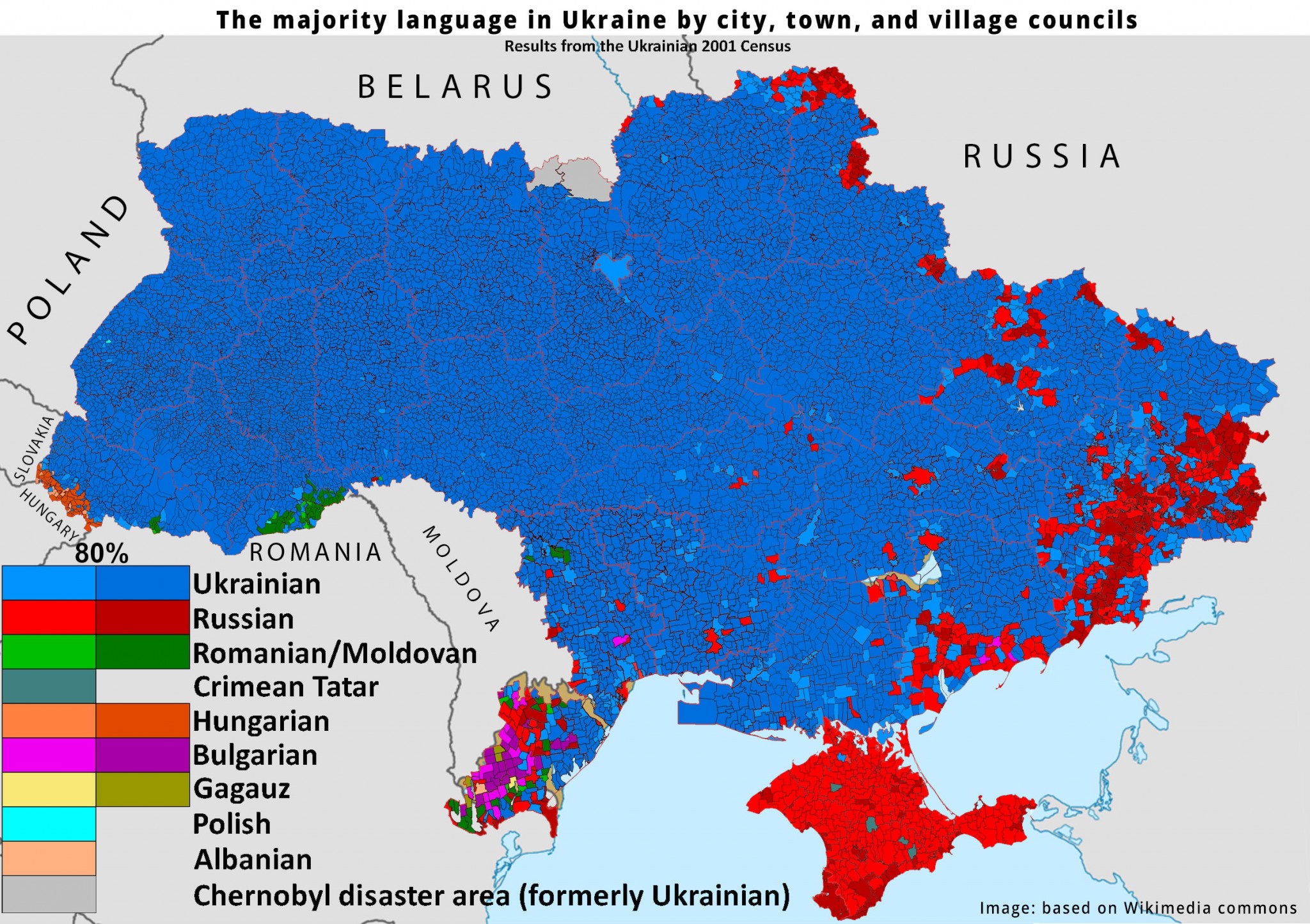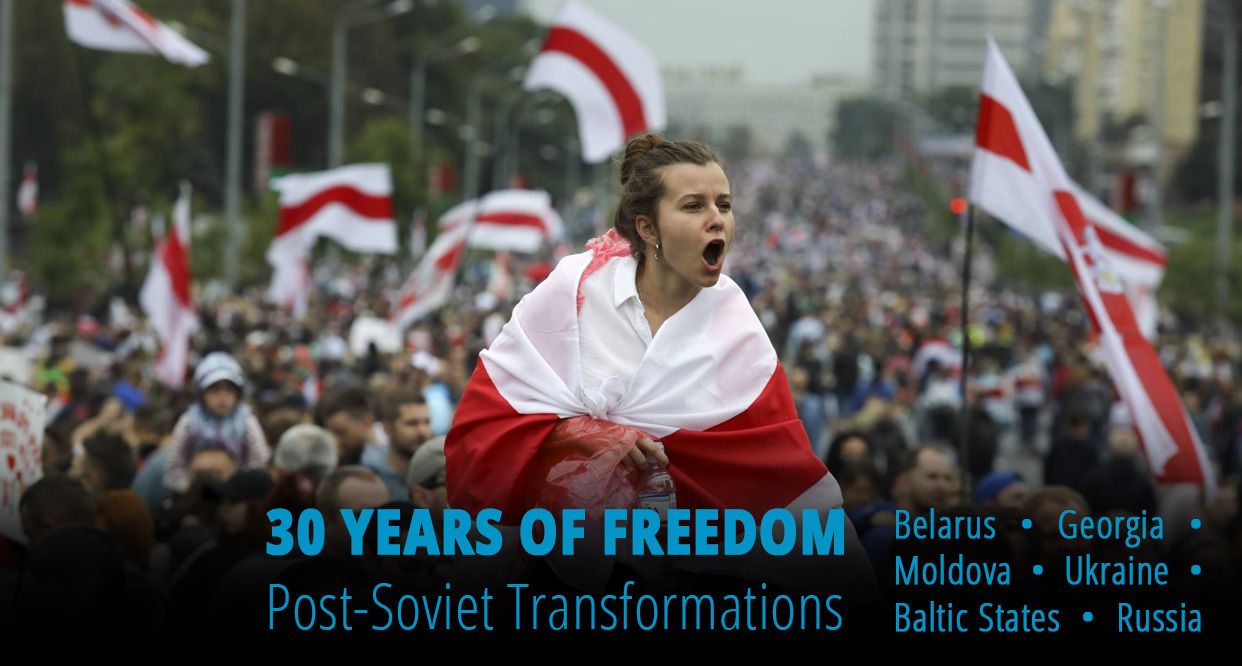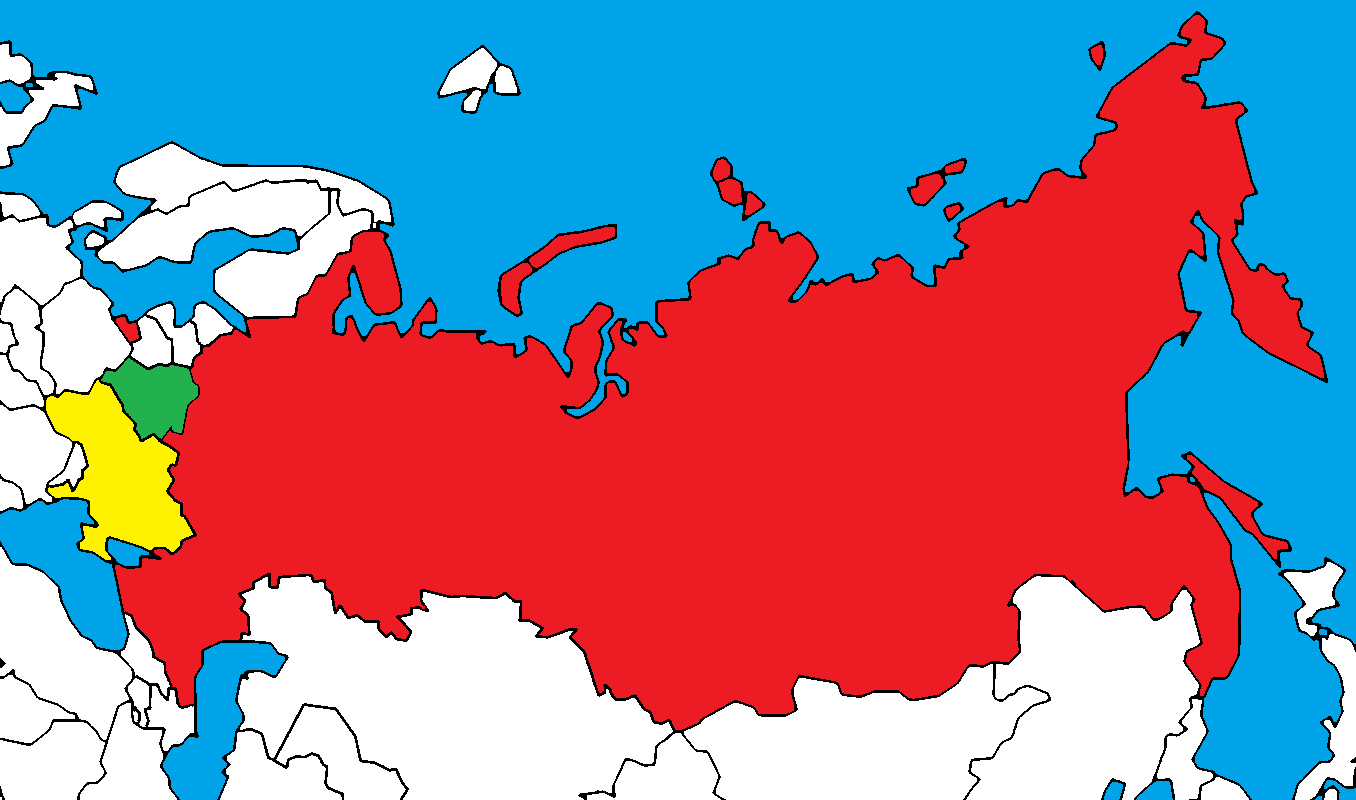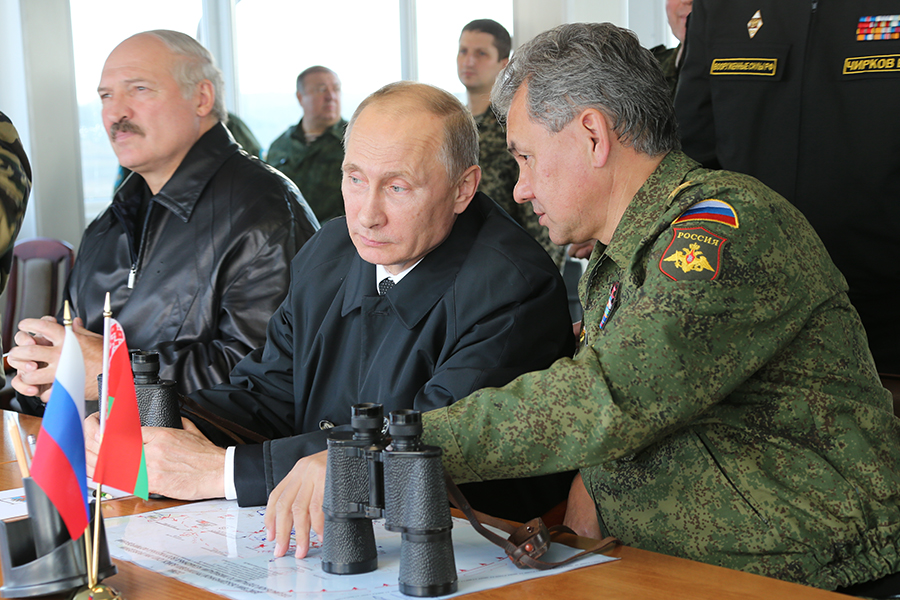30 years of independence is a relatively short period for post-Soviet states that were part of the Russian Empire for 150 years and then subjugated by the USSR for the next 45-70 years. In the last 30 years, they have faced a task to not only create democratic institutions but to unify and modernize the nations that could operate them, replacing the artificial "Soviet identity" with a national one.
In the third part of the four-part series, 30 Years of Freedom, ten speakers from Belarus, Ukraine, Georgia, Moldova, Russia, and the Baltics elaborated on how their countries built their national identities and unified their nations after the disintegration of the USSR, key events for nation-building, and how they reappraised their historical narratives.
All four parts are based on the comments of our speakers, including quotes from their published essays:
- Part One. Demolishing monuments not enough to destroy post-Soviet nostalgia, but property rights help | 30 Years of Freedom, p.1
- Part Two. The post-Soviet oligarchy and how it shaped national state politics | 30 Years of Freedom, p.2
- Part Three. The end of the Soviet Man: How ex-USSR states forged their national identities | 30 Years of Freedom, p.3
- Part Four. How to stop Russian wars in post-Soviet states? | 30 Years of Freedom, p.4
 In 1920, when hopes were high for the creation of an independent Ukraine, Georgia, Belarus, and Baltic states, the national independence struggles were mostly ended with occupation by the USSR. The Baltic states, Moldova, and western Ukraine were engulfed by the “Prison of Nations” a bit later, in 1945, the end of WWII.
During the times of the USSR, communist authorities constructed an artificial "Soviet identity." In the post-WWII period, its cornerstone was the myth of the Great Patriotic War which attempted to coalesce differing nationalities around the myth of the Great Victory of the Soviet people. At the same, the secret Nazi-Soviet Molotov-Ribbentrop pact was smearing national resistance movements that fought against the Soviets during WWII.
In 1991, at the downfall of the Soviet Union, the national identity and consciousness of the nascent states were still unclear. As sociologists concur, the majority of people in post-Soviet states were disoriented when the USSR fell apart.
Roughly a third identified themselves merely as residents of a certain town or region. Another third named different identifications, including “Soviet (wo)man” – a popular terminology of the time. Only the last third considered themselves primarily as citizens of the new Ukraine, Belarus, Georgia, and so on.
The issue was further clouded by Soviet demographic policy. On the one hand, it created proxy and quasi-folk national identities, and on the other tried to mix or resettle populations and assimilate them into the Russian world. This largely explains why in the 1990s, the Russian language was popular and people were diffident about the simulacra of their national cultures.
Today things are changing as integral, modern national cultures evolve.
Central to many discussions is the deconstruction of the Great Patriotic War myth: viewing the events of WWII not through a victorious, but a tragic lens, as well as reassessing the role of insurgents who fought against the Red Army.
As our speakers outline in detail, Ukrainians, Moldovans, Belarusians, and Georgians have undergone a difficult process of reassessing WWII and rediscovering key events of their history, in the journey to reach their unique formula for consensus – albeit still fragile.
Lithuania, Latvia, and Estonia tried different ways to deal with strong Russian opposition and prevent the Russification of their states – a process also relevant for other post-Soviet states.
In today’s Russia, the opposition seeks to revive the idea of a democratic Russia and construct a political model for it, contrary to Putin’s narrative of reviving the empire.
In 1920, when hopes were high for the creation of an independent Ukraine, Georgia, Belarus, and Baltic states, the national independence struggles were mostly ended with occupation by the USSR. The Baltic states, Moldova, and western Ukraine were engulfed by the “Prison of Nations” a bit later, in 1945, the end of WWII.
During the times of the USSR, communist authorities constructed an artificial "Soviet identity." In the post-WWII period, its cornerstone was the myth of the Great Patriotic War which attempted to coalesce differing nationalities around the myth of the Great Victory of the Soviet people. At the same, the secret Nazi-Soviet Molotov-Ribbentrop pact was smearing national resistance movements that fought against the Soviets during WWII.
In 1991, at the downfall of the Soviet Union, the national identity and consciousness of the nascent states were still unclear. As sociologists concur, the majority of people in post-Soviet states were disoriented when the USSR fell apart.
Roughly a third identified themselves merely as residents of a certain town or region. Another third named different identifications, including “Soviet (wo)man” – a popular terminology of the time. Only the last third considered themselves primarily as citizens of the new Ukraine, Belarus, Georgia, and so on.
The issue was further clouded by Soviet demographic policy. On the one hand, it created proxy and quasi-folk national identities, and on the other tried to mix or resettle populations and assimilate them into the Russian world. This largely explains why in the 1990s, the Russian language was popular and people were diffident about the simulacra of their national cultures.
Today things are changing as integral, modern national cultures evolve.
Central to many discussions is the deconstruction of the Great Patriotic War myth: viewing the events of WWII not through a victorious, but a tragic lens, as well as reassessing the role of insurgents who fought against the Red Army.
As our speakers outline in detail, Ukrainians, Moldovans, Belarusians, and Georgians have undergone a difficult process of reassessing WWII and rediscovering key events of their history, in the journey to reach their unique formula for consensus – albeit still fragile.
Lithuania, Latvia, and Estonia tried different ways to deal with strong Russian opposition and prevent the Russification of their states – a process also relevant for other post-Soviet states.
In today’s Russia, the opposition seeks to revive the idea of a democratic Russia and construct a political model for it, contrary to Putin’s narrative of reviving the empire.

Belarus
As political analyst Artyom Shreibman states, Belarus has progressed from the most Russified country to a country with a strong civic national identity centered around the free Belarusian state. Although the Belarusian language and culture are still a minority in Belarus and people mostly speak Russian, they do not consider themselves to be Russians and no longer want political unity with Russia.
Shreibman: Belarusians' appreciation of their national identity is not similar to that of Ukrainians' because it is not centered on the issue of language, nor on the issue of national symbols or ethnocultural issues. Belarusian nationalism is sometimes described as civic, i.e. centered on statehood. It is a very distinctive kind of civic nationalism. According to the polls, Belarusians don’t support merging with Russia, for example. These numbers are in the single digits – five, six, seven percent, depending on how you ask the question. An additional 12-15% might support deeper integration with Russia, in some sort of EU structure. Everyone else supports preserving independence. Independence has become a value. It was not a quick process, but a very gradual one. The majority of Belarusians are pro-Russian in that we are friendly towards Russians as a nation and support an economic union with Russia, unlike Ukrainians, for example. At the same time, there is a similar appreciation of independence, as you see in Ukraine. Let’s not understand these words as black and white, rather as the reality at the ground level. Belarusians are not in favor of any kind of concessions in terms of their sovereignty. Speaking Russian in these circumstances is not a contradiction to Belarusians. They see it possibly in the same way as the Irish see their independence from the UK. Belarusians have their separate identity which is important to them – the Belarusian identity for the Belarusians.Belarusian nationalism is sometimes described as civic, i.e., centered on statehood

The polls that I have seen demonstrate a couple of things. First of all, victory in the Second World War and Victory Day is still the key event in historical memory. Belarusians are less tolerant towards the renaming of streets, relocation of Soviet monuments, and other decommunization proposals. This reflects a very important myth about the Great Patriotic War, as many still call it in Belarus. Every fourth Belarusian died in the Second World War, and everybody has relatives who suffered – that’s why it is the cornerstone of national memory. I’m not aware of any regional differences. Generally, Belarus is quite a homogeneous country. It is different from Ukraine in this regard. There are very small differences in terms of support for Lukashenka. In the east of Belarus, it’s slightly higher but not by much. However, there are no significant differences among Belarusians on these historic issues.Every fourth Belarusian died in the Second World War
The history of the Grand Duchy of Lithuania (when Belarus was the biggest part of that state) is what poet, translator and former president of Belarusian PEN Andrei Khadanovich names the Golden Age of Belarusian history. This European Belarus (marked by a white-red-white flag) now struggles against Lukashenka’s regime, which has become an extension of Putin’s Russia because of the 2021 deployment of Russian troops and the increased financial dependence of Lukashenka on Russia. Khadanovich speaks Belarusian and represents the perspective of Belarusian cultural elites, and therefore puts more emphasis on language and culture, unlike Shreibman.
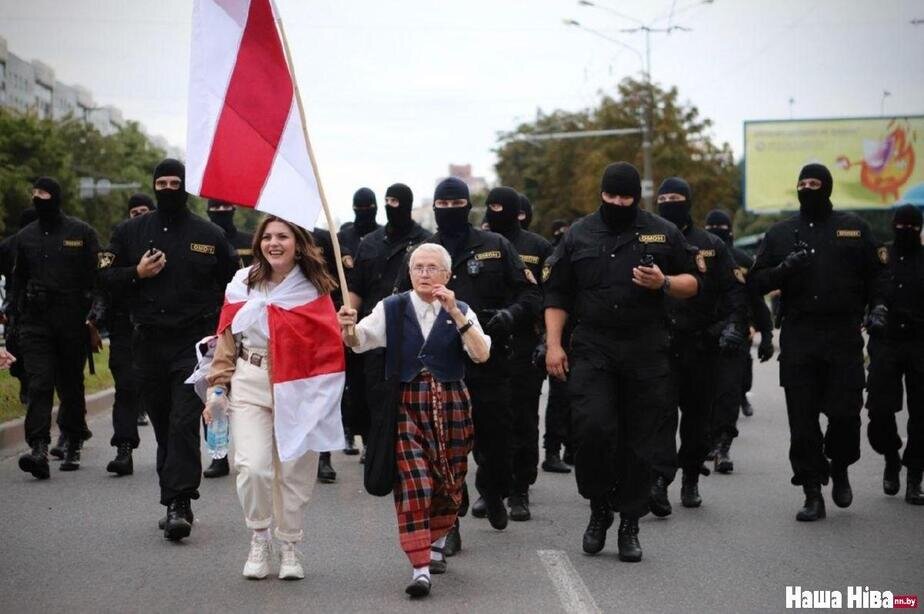
Moldova
Paula Erizanu, Moldovan writer and culture editor of the Calvert Journal, points out that there is no difference between the Moldovan and Romanian languages. The culture of the two countries is so intertwined that she considers herself both a Romanian and Moldovan author, as do many other Moldovans who also have dual citizenship. At the same time, the promotion of political unification with Romania, active in the early 1990s, is no longer popular. Instead, people demand economic and institutional reforms in Moldova, rather than geopolitical changes.
I think I’m both a Romanian and Moldovan writer, and I also have both citizenships. Definitely, over a million people have this double citizenship. The discussion about political unification with Romania is now promoted only by a few small political parties and the media. Some of the parties are quite controversial – not really aiming to unite with Romania, but perhaps just aiming to divide society. It seems to me that right now at the forefront of peoples’ political ambitions and needs is the reformation of the state into a functioning democratic state that serves its citizens. Our ties have become closer with Romania since Maia Sandu was elected Moldovan president in 2020. Romania has provided a lot of help to Moldova; for example, restoring kindergartens across the country, the National Art Museum, and so on. So it feels like we have moved on from a sentimental discourse between Romania and Moldova to a stage when history and close identity – or even the same identity – is manifested in actual pragmatic support. Soviet authorities in Moldova tried to reinforce Moldovan identity as distinct from Romanian identity. I think our cultural opposition to the regime during Soviet times was much linked to these identity issues. For example, writers in the 1960s wanted to go back to writing Romanian in the Latin alphabet and some were declined by publishers because of their position on this matter. In the late 1980s, that kind of spirit revived once again and the independence movement was led by cultural figures – by writers in particular, as well as vocalists, and so on. They heralded the things we shared with Romanians and had in common with them prior to forced Russification by the Soviets.We have moved on from a sentimental discourse between Romania and Moldova to a stage when close identity is manifested in actual pragmatic support



According to sociologist Petru Negura, Moldova's history is closely linked to Romania's. This is why the issue of unification with Romania was quite popular in Moldova in the 1990s. But on the other hand, unlike Romania, Moldova was part of the Russian Empire for a century and part of the USSR starting in 1944. The USSR partially succeeded in building a separate Moldovan identity. Close cultural ties with Romania remain, but unification is no longer a hot topic. Different interpretations of WWII do not cause conflicts in everyday life.

Yes, Moldova and Romania had a complicated relationship, especially during the interwar period from 1918 to 1940 when Moldovan Bessarabia was part of Romania. Added to this is perhaps the war period itself when Ion Antonescu was in power. Antonescu was quite proto-fascist at that time and went so far as to instigate a Holocaust in Bessarabia and Transnistria. But beyond this episode of WWII, Romania ruled Bessarabia for 22 years. This may not be considered very long, but enough for the nation-building process in Moldova. However, this nation-building was without Transnistria, because Transnistria at that time was a Soviet republic within Ukraine – an autonomous Soviet republic within the territory of the Ukrainian Soviet Socialist Republic. In the interwar period, Romania helped develop the intellectual elite of Moldova. Those 22 years were very important in Moldova’s nation-building process. However, I don’t mean to overemphasize the importance of Romania when it comes to Bessarabia. Yes, Moldova had a 22-year history with Romania, but we also had close to a century under the Russian Empire and then a further 50 years under the Soviet Union. Even though it was the Romanian authorities who started mass education in Moldova, especially in the countryside, they did not complete the process. Just to give you one example, in the late 1930s almost half of our population were still illiterate. In this, I would say, lies a large part of the failure of the Romanian modernization effort, which is why the Soviets succeeded (perhaps only slightly more than Romania) in promoting a Soviet nation-building agenda. In other words, encouraging a Moldovan identity apart from that of Romanians. Ben: As you mentioned, during WWII Moldova was part of Romania. How does this fact impact the contemporary perception of WWII? Was it a victory or occupation when the Soviets arrived?In the interwar period, Romania helped develop the intellectual elite of Moldova, which was important for nation-building


Georgia
Historian David Jishkariani emphasizes the importance of the First Georgian Democratic Republic which only existed for three incomplete years (1918-1921), yet was key to the formation of the national identity of Georgia. Centered around Georgian ethnicity, the republic was nonetheless as diverse as is contemporary Georgia. Georgian identity was influenced by a 200-year struggle against Russian dominance.
Ideological, ethno-cultural divisions and the WWII narrative are relatively not important for contemporary Georgians. Conversely, both ethno-cultural divisions and the WWII narrative were actively exploited by the USSR – and currently the Kremlin – to divide Georgia and justify the occupation of its regions.
Jishkariani: WWII is not discussed as much in today’s Georgia as it is in Russia and Ukraine. Of course, the population of the Georgian Soviet Socialist Republic participated in WWII and Georgia received many refugees. But on the territory of Georgia there was no Nazi occupation and no military operations. For Georgians, WWII is an event that affected people, but it was not as important as it was for Russia, where WWII is the core of the new Russian identity. WWII is discussed in Georgia annually on only two days: the 8th and 9th of May. And the discussion is predominantly about when to celebrate, on the 8th or 9th. Yet, there is great reverence for soldiers who fought in the war, because it was a tragedy for young people to have experienced these terrible events. In almost every village, you can find small monuments with names of soldiers who left the village and never returned. These monuments were erected during Soviet days, but sometimes when they have deteriorated local villagers gather to restore them. Another difficult question in Georgian history is how to consider those who fought with the Nazis. Like Ukrainian battalions within the Nazi army, there were also Georgian battalions. The question is whether we need to equate them with the Red Army soldiers. Both of them believe they were struggling for Georgia.WWII was not as important for Georgia as it was for Russia
Regarding contemporary Georgian political identity, one may say that independence from Russia – cultural and political – is more important than the anti-Soviet or decommunization policies. The USSR was considered through the lens of struggling against Russian domination. At the same time, the USSR had its clear ethnic policy with the aim of constructing a Georgian nation, while demanding their policies be imposed vis a vis Ossetians and Abkhazians [ethnic groups in Soviet Georgia at times recognized as autonomous regions -ed.]. We have to understand that constructing nations was a process – the Georgian nation was constructed, as were other nations, and now this process continues.The USSR was considered through the lens of struggling against Russian domination


Jishkariani recommends several books on Georgian history that cover the issue of national identity and its formation:
- Donald Rayfield Edge of Empires: A History of Georgia
- Stephen Jones Socialism in Georgian Colors: The European Road to Social Democracy, 1883–1917
- Ronald Suny The Making of the Georgian Nation
Lithuania, Latvia, Estonia
All three Baltic states were annexed by the Russian Empire in the 18th century and, after a short interwar period of independence, by the USSR. With Soviet dominance came strong Russian minorities in all three small states. Sovietologist Robert van Voren and political scientist Sarunas Liekis explained which policies helped to integrate Russians and thus limit the influence of Russia. According to these experts, WWII is clearly viewed in the Baltics as the occupation by the USSR and, unlike some republics, there is no dispute about this.
Policies regarding Russian minority

Russia
Andrey Zubov, Russian historian and opposition politician, asserts the need to reconsider WWII in Russia according to the resolution that was adopted by PACE (Parliamentary Assembly of the Council of Europe) in September 2019. He also elaborates on the historical examples for the Russian democratic state and talks about education as the strongest tool to break the historical legacy.


Ukraine
Historian Yaroslav Hrytsak defines the 17th century Cossack state and the historical memory of Cossacks as the cornerstone of Ukrainian identity, emphasizing two factors: Ukrainian language, and aspirations for freedom and democracy, both tracing back to the functioning democracy of the Ukrainian Cossacks. The peculiarity of Ukraine’s nation-building is that writers and their publications had much greater influence and played a far more important role than did politicians, compared to Western Europe. This explains why the Ukrainian language and Ukrainian literature still have a strong political role today. Ukrainian contemporary writers – not politicians – are the strongest advocates of modern Ukrainian national identity, now that they have moved past post-colonial wounds and are free of Russian subjugation.
In his essay on Ukrainian identity, Hrytsak elaborates on two additional elements of Ukraine’s identity and the competition between them in contemporary politics.
